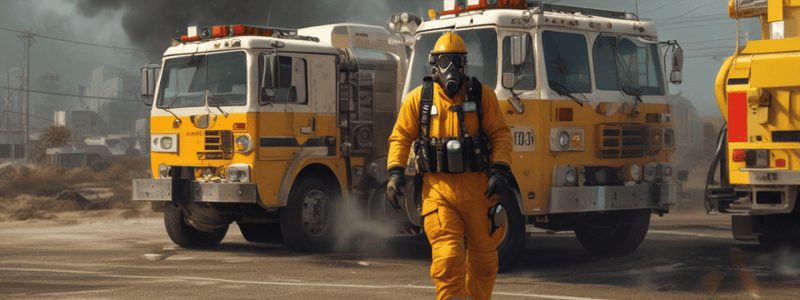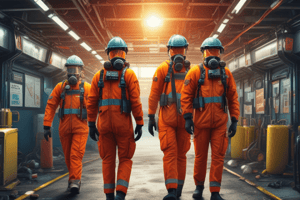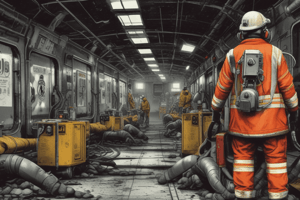Podcast
Questions and Answers
What should be done when working near blow-out/blast panels?
What should be done when working near blow-out/blast panels?
- Shut off the power supply to the ESS
- Use a master fire stream to cool the area
- Take caution and note the location (correct)
- Ventilate the area immediately
Why should power be shut off in a residential ESS fire?
Why should power be shut off in a residential ESS fire?
- To prevent electrical shock
- To ensure a safe distance from the ESS
- To protect exposures
- To reduce the risk of the fire spreading (correct)
What should Incident Commanders do in a residential ESS fire?
What should Incident Commanders do in a residential ESS fire?
- Use a single hose line to extinguish the fire
- Take a defensive stance (correct)
- Evacuate the area
- Take an offensive stance
Why is it important to ensure a dedicated water supply?
Why is it important to ensure a dedicated water supply?
What is the minimum requirement for hose lines in a residential ESS fire?
What is the minimum requirement for hose lines in a residential ESS fire?
How long may it take for battery packs to cool down and be completely drained of power?
How long may it take for battery packs to cool down and be completely drained of power?
What is the first step in responding to a commercial or utility installation incident?
What is the first step in responding to a commercial or utility installation incident?
Why should water not be used to extinguish a thermal runaway?
Why should water not be used to extinguish a thermal runaway?
Who should be consulted if the manufacturer or on-site Support is not available?
Who should be consulted if the manufacturer or on-site Support is not available?
What is the minimum number of hose lines recommended for extinguishment?
What is the minimum number of hose lines recommended for extinguishment?
What should be done to the building or vault doors in the event of a fire or smoke?
What should be done to the building or vault doors in the event of a fire or smoke?
Why is post-incident decontamination necessary?
Why is post-incident decontamination necessary?
What should be considered by the Incident Commander during extended firefighting operations?
What should be considered by the Incident Commander during extended firefighting operations?
What is the preferred extinguishing agent for responding to LIB incidents?
What is the preferred extinguishing agent for responding to LIB incidents?
Flashcards are hidden until you start studying
Study Notes
Incident Operations
- If responding to a commercial or utility installation, follow Site Pre-plan and do not enter the ESS installation.
- For residential responses, shut off power to the unit, ventilate the area, and protect exposures.
- Contact the manufacturer, emergency contact, or on-site Support as soon as possible.
Confined Space Incident
- Do not enter an ESS vault, consider it a Confined Space Incident, and follow current TFS SOGs and Training Notes.
Water Safety
- Water may not prevent a battery from entering thermal runaway.
- Water can provide a cooling effect on adjacent battery cells.
Hazmat Response
- If the manufacturer or on-site Support is not available, consult with the Hazmat Captain, Incident Commander, and possibly CANUTEC.
Post-Incident Decontamination
- Post-incident decontamination will be undertaken by crews exposed to smoke, vapors, or contaminants during the incident, following TFS TN 104.2.
Commercial or Public Utility ESS Fire Response
- Conduct an incident size-up, including a 360-degree assessment.
- Take a defensive stance, prepare to apply water, and protect exposures.
- Establish a safe exclusion zone, evacuate where possible, and dedicate a water supply.
- Use multiple hose lines (min. 2 x 65mm hose lines, 950 L/min each) and consider master fire streams.
- Prevent building or vault doors from being opened and prevent entry into the vault or building.
- Consider allowing the LIB to burn itself out, which may take up to 12 hours or more.
Residential ESS Fire Response
- Conduct an incident size-up, including a 360-degree assessment.
- Shut off power to the unit, ventilate the area, and protect exposures.
- Take a defensive stance, ensure a dedicated water supply, and maintain a safe distance from the ESS.
- Ensure the space is properly ventilated and monitor incident conditions.
Studying That Suits You
Use AI to generate personalized quizzes and flashcards to suit your learning preferences.




